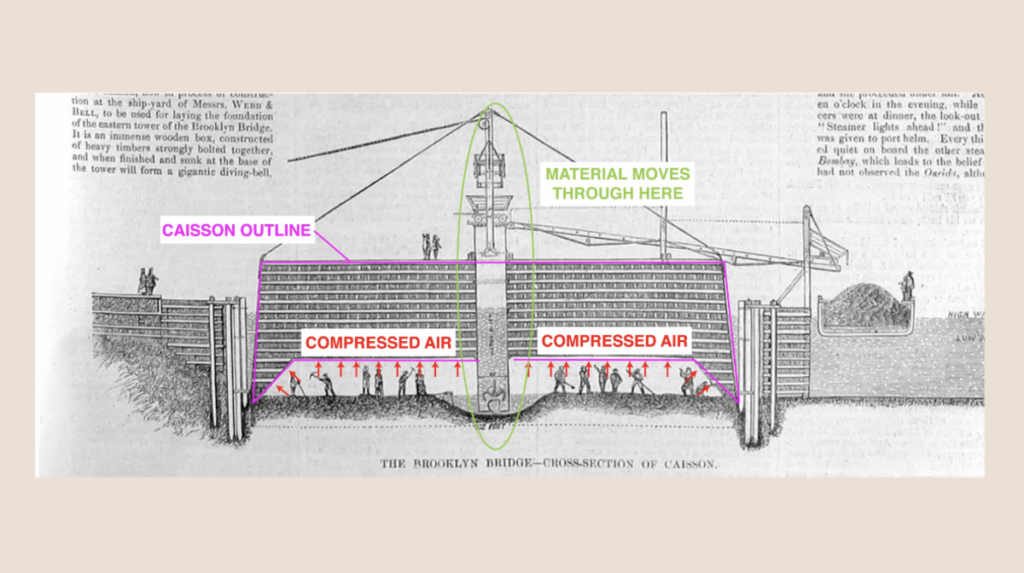In Case Anyone Else Has Stopped to Think About How the Brooklyn Bridge Was Built

At UChicago, we had a handful of sardonic “mottos” that were plastered on the sweatshirts of students wherever you turned. Campus favorites were “Where fun goes to die”, “Where the odds are good, but the goods are odd”, and “Where the squirrels are cuter than the girls and more aggressive than the guys”. One in particular has haunted me since graduation, particularly on airplanes, in underwater tunnels, and whenever I hear about the miracle that is childbirth (hearing a “miracle” is going to happen to you is *quite* comforting): “That’s all well and good in practice but how does it work in theory?
Does no one else have even an inkling of pause going over a bridge made 140 years ago without any modern technology? On May 24, 1883, the Brooklyn Bridge opened after taking more than a decade to build, killing its designer, and opening with massive (deserved) skepticism. Since I could write a whole newsletter about this topic, we’re going to lightly touch on the barbaric ways this thing that hundreds of thousands of people cross a day was built.

People toiled in inhumane conditions to build the footing to the towers
The foundation of the bridge’s two towers started off with caissons, which were large wooden boxes with no bottoms. They were towed into position and sunk on the river bottom. Compressed air was then pumped into the chambers to keep water from rushing in and men inside dug away at the mud and bedrock at the bottom of the river. Airlocks maintained the air pressure inside the caissons. When workers reached solid bedrock, the caissons were filled with concrete, thus becoming the foundation for the bridge. Work inside the caisson was exceedingly difficult; air quality was poor, they relied on gas lamps, and workers had to pass through a series of airlocks to enter the chamber where they worked. When they exited, the compressed air atmosphere often inflicted “the bends,” a hazardous condition where nitrogen bubbles form in the bloodstream, which caused many men to die – seeing it was the 1800s, an entirely lawless century, working conditions went unchanged through completion.

The towers are pretty much made of haphazardly stacked blocks
The towers, when completed, rose nearly 300 feet above the water of the East River. Massive cut stone was towed on barges to the bridge location, and workers hoisted the blocks into position using wooden cranes. An interesting aspect of the bridge construction is that while the finished bridge would use novel materials including steel girders and wire rope, the towers were built using technology which had existed for centuries. Both towers were completed by July 1876 and subsequently the cables began their installation in August 1876.

THIS WOODEN PLANK OF DEATH WAS SOMEONE’S JOB SITE
The temporary footbridge strung between the towers of the Brooklyn Bridge in 1877 was not for the timid. The walkway was made of rope and wooden planks, stood 250 feet above the East River, and would sway violently in the wind. Excuse me?

All of the cables were HAND SPUN in the air by people on open-air carts
The main cables were installed first, followed by the secondary suspender wires which would hang from the main cables and support the deck. The main cables were constructed by winding together smaller steel wires and all of this had to be done hundreds of feet above the river. Spinning the wires for the main suspension cables began in the summer of 1877, and took a year and a half to complete. A device would travel back and forth between each anchorage, placing the wire into the cables. At one point all four cables were being strung at once, and the bridge resembled a gigantic spinning machine. Besides the difficult conditions, the work was exacting, as the strength of the entire bridge depended on the cables being spun to precise specification.
Has your curiosity been piqued and do you want to waste a few more hours on the topic?
1. A bunch of terrifying photos of the bridge under construction
2. 15 fun-if-you-love-history facts about the Brooklyn Bridge
3. Images of the Brooklyn Bridge through its 140+ years of existence
4. Emily Warren Roebling, the reason behind why the bridge was successfully built
5. A TedEd video on the topic in case reading isn’t your thing